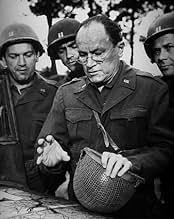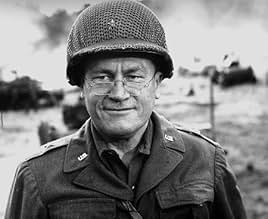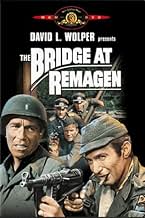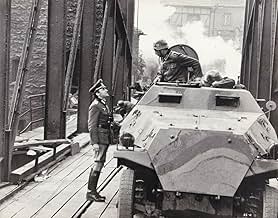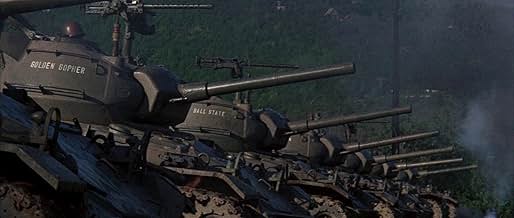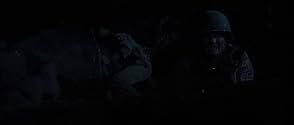NOTE IMDb
6,7/10
11 k
MA NOTE
Ajouter une intrigue dans votre langueAs the Allied armies close in, the Germans decide to blow up the last Rhine bridge, trapping their own men on the wrong side. But will it happen?As the Allied armies close in, the Germans decide to blow up the last Rhine bridge, trapping their own men on the wrong side. But will it happen?As the Allied armies close in, the Germans decide to blow up the last Rhine bridge, trapping their own men on the wrong side. But will it happen?
- Réalisation
- Scénario
- Casting principal
Peter van Eyck
- Gen. Von Brock
- (as Peter Van Eyck)
Anna Gaël
- French Girl
- (as Anna Gael)
Vít Olmer
- Lt. Zimring
- (as Vit Olmer)
Avis à la une
This is a no-nonsense, gritty, thoroughly well made war film. As a recreation of war it is quite convincing, I couldn't spot anything wrong with the military equipment. The battle scenes are exciting and give a good, clear picture of the fighting instead of just chaotic shots of shooting and explosions. However, the people are never lost among the warfare. These are complex, solid characters, and the actors are good throughout. There is nothing superhuman, just individuals, very low on humanity or manners. Tired and ill-motivated Americans, desperate and scared Germans. Nothing glorious or patriotic: there is even a scene with American planes bombing refugees and Germans trying to protect them! This is not an adventure, more a depiction of an interesting situation and the people in it. However, the story flows on and there isn't a dull moment. Why this film hasn't acquired more recognition is beyond me. As a war film I think it is better than most of it's contemporaries, like "The Battle of the Bulge" or "Anzio".
This has to be one of the best war movies made in the 1960s, an era when all too often filmmakers went overboard in glorifying war while glossing over its horrors and populating their movies with larger-than-life hero characters who could have come straight out of a boys' comic. This movie doesn't fall into that trap. The characters - both German and American - are believable, and the movie sets and the equipment used (with the glaring exception of Korean War era American tanks) are authentic for the period. With so many WWII Sherman tanks and other vehicles still in museums, private collections and (at least back in the 60s) still in use in large numbers in the armies of several smaller countries, it has always been a puzzle to me as to why so many moviemakers took the simple option and used anachronistic military hardware in WWII movies, presumably assuming that the average moviegoer wouldn't even notice or wouldn't care. The most horrible example of this is the 1965 movie "Battle Of The Bulge". But I digress. Ignoring the tank factor, "The Bridge At Remagen" is a great movie. The best performance among many strong ones in this film has to be that of Ben Gazzara as Sergeant "Angel" Angelo, and the scene in which he kills the German sniper is extremely strong, moving stuff. Highly recommended.
American director John Guillermin, known for several epic "clunkers", pulls together this rather tense look at one of the most important battles of World War II: American forces clash with the Germans at Remagen, where the last intact bridge over the Rhine stands between the two opposing forces.
The script divides attention evenly and fairly between the two forces. George Segal ("The Longest Day") is Lt. Hartman, a burned out and pretty tired junior officer who doesn't want to accept the responsibilities of command when his company commander is killed. The war is almost over, and Hartman is concerned with getting his men home. On the other side of the river, German Major Kreuger (Robert Vaughn) is equally concerned with saving lives German lives. He becomes obsessed with keeping the bridge intact in order to allow retreating German soldiers to attack, despite orders from the High Command to blow up the bridge to prevent its' capture by the Allies.
The supporting cast is filled with fine performances. The standouts are Hans Christian Blech ("Battle of the Bulge") as Captain Schmidt, a weary Wehrmacht Officer who feels his duty is to protect the civilians whom Kreuger puts in harm's way by continuing a hopeless fight. Blech's acting ability ranges from quiet humility to occasional fits of rage, bringing a dimensionality to a role not commonly found in war epics. Joachim Hansen ("Breakthrough") disagrees with Schmidt; he is devoted to the High Command and wants a battle with the Americans more than anything. Both actors bring passion to their roles and make these very believable wartime officers, not simply normal caricatures and stereotypes.
Guillermin takes these characters and puts them in intense combat situations, making their humanity all the more believable. The best battle scene in the film has a platoon of American soldiers advancing onto the bridge under a smokescreen, but while they are in the open, the smoke begins to clear giving the Germans a clear field of fire. As some men are shot in the open, others move underneath the bridge to try and rip off as many explosives as they can before the Germans can ignite a secondary fuse to blow up the bridge.
In the aftermath of battle scenes like this, the human drama unfolds. Sgt. Angelo (Ben Gazzara, "Fireball Forward") is a tough GI who loots the bodies of the dead and sees the war around him as a chance to get rich and take the wealth home when it's all over. But when he must shoot a Hitler Youth member who is sniping at his men, then weeps when he realizes he has shot a mere pre-teenage boy. During a lull in the siege on the bridge, Hartman faces off with Maj. Barnes (Bradford Dillman), who wants him to take his men onto the bridge and capture it despite enemy fire and the threat of the bridge's imminent destruction. Hartman argues that he cannot risk the lives of his men; Barnes states that it will help to end the war faster is the bridge is captured, thus saving more lives in the end. It's a tough choice to make, and both decisions have their drawbacks.
The performances are complimented by three crucial technical elements: scoring, scenery and cinematography. Elmer Bernstein provides a sweeping score which resounds with the troops when they are victorious, yet mourns and seems to cry during some heart-wrenching scenes, such as an important scene between Angelo, Hartman and Schmidt at the film's conclusion. The Czech locations look magnificent the film looks and feels real because it was lensed in Europe, in a location which passes for Germany perfectly. The cobblestones streets, rustic villages, rolling hills and clear rivers look amazing. Finally, Stanley Cortez's cinematography is fantastic; the composition of every shot looks well-planned and detailed. There is action going on in the background and foreground most of the time. The focus is not just on the main characters, but as in real life, there is stuff going on around them. Scenes of the battle on the bridge are standouts, as the action is captured from every possible angle, it's very clear what's going on and who is where at all times.
"The Bridge at Remagen" is a fine World War II film which succeeds in showing history, American patriotism and the horrors of war at the same time. It will leave you feeling glad that the Allies won the war and agonized over the great cost of such small gains. But when you realize how much a "small" gain really matters in the big picture, it won't seem as small anymore.
The script divides attention evenly and fairly between the two forces. George Segal ("The Longest Day") is Lt. Hartman, a burned out and pretty tired junior officer who doesn't want to accept the responsibilities of command when his company commander is killed. The war is almost over, and Hartman is concerned with getting his men home. On the other side of the river, German Major Kreuger (Robert Vaughn) is equally concerned with saving lives German lives. He becomes obsessed with keeping the bridge intact in order to allow retreating German soldiers to attack, despite orders from the High Command to blow up the bridge to prevent its' capture by the Allies.
The supporting cast is filled with fine performances. The standouts are Hans Christian Blech ("Battle of the Bulge") as Captain Schmidt, a weary Wehrmacht Officer who feels his duty is to protect the civilians whom Kreuger puts in harm's way by continuing a hopeless fight. Blech's acting ability ranges from quiet humility to occasional fits of rage, bringing a dimensionality to a role not commonly found in war epics. Joachim Hansen ("Breakthrough") disagrees with Schmidt; he is devoted to the High Command and wants a battle with the Americans more than anything. Both actors bring passion to their roles and make these very believable wartime officers, not simply normal caricatures and stereotypes.
Guillermin takes these characters and puts them in intense combat situations, making their humanity all the more believable. The best battle scene in the film has a platoon of American soldiers advancing onto the bridge under a smokescreen, but while they are in the open, the smoke begins to clear giving the Germans a clear field of fire. As some men are shot in the open, others move underneath the bridge to try and rip off as many explosives as they can before the Germans can ignite a secondary fuse to blow up the bridge.
In the aftermath of battle scenes like this, the human drama unfolds. Sgt. Angelo (Ben Gazzara, "Fireball Forward") is a tough GI who loots the bodies of the dead and sees the war around him as a chance to get rich and take the wealth home when it's all over. But when he must shoot a Hitler Youth member who is sniping at his men, then weeps when he realizes he has shot a mere pre-teenage boy. During a lull in the siege on the bridge, Hartman faces off with Maj. Barnes (Bradford Dillman), who wants him to take his men onto the bridge and capture it despite enemy fire and the threat of the bridge's imminent destruction. Hartman argues that he cannot risk the lives of his men; Barnes states that it will help to end the war faster is the bridge is captured, thus saving more lives in the end. It's a tough choice to make, and both decisions have their drawbacks.
The performances are complimented by three crucial technical elements: scoring, scenery and cinematography. Elmer Bernstein provides a sweeping score which resounds with the troops when they are victorious, yet mourns and seems to cry during some heart-wrenching scenes, such as an important scene between Angelo, Hartman and Schmidt at the film's conclusion. The Czech locations look magnificent the film looks and feels real because it was lensed in Europe, in a location which passes for Germany perfectly. The cobblestones streets, rustic villages, rolling hills and clear rivers look amazing. Finally, Stanley Cortez's cinematography is fantastic; the composition of every shot looks well-planned and detailed. There is action going on in the background and foreground most of the time. The focus is not just on the main characters, but as in real life, there is stuff going on around them. Scenes of the battle on the bridge are standouts, as the action is captured from every possible angle, it's very clear what's going on and who is where at all times.
"The Bridge at Remagen" is a fine World War II film which succeeds in showing history, American patriotism and the horrors of war at the same time. It will leave you feeling glad that the Allies won the war and agonized over the great cost of such small gains. But when you realize how much a "small" gain really matters in the big picture, it won't seem as small anymore.
Truth is often stranger than fiction we know. What's more perplexing is having seen 'The Bridge At Remagen,' you may think it more or less happened that way which was intriguing to say the least.
*** SPOILERS ***
In reality, the events surrounding the capture of this bridge were even more bizarre and surely never was there such great coincidence. These elements of the movie happened in reality:
-the bridge at Remagen was accidentally captured intact by US forces;
-the Germans unsuccessfully tried to blow it up, repeatedly;
-the Americans lost a lot of men in the fighting around the bridges;
-the German commander of the defense at the bridge was court martialed and executed by the Germans;
Following are the more bizarre real events of the bridge at Remagen. The commander of the US re con force that spotted the bridge first, was an man named Karl Timmerman! This US Lieutenant was of German descent. His father had stayed in Europe following his tour of duty during the First World War. There his father met his future mother in Germany. Karl Timmerman was born and grew up in Germany, NEAR the bridge at Remagen. He and his parents then moved to the States.
Timmerman and his men took the bridge and the Germans guarding it completely by surprise. No men were lost and the relative small squad quickly disabled the defending machineguns and captured all defenders without firing a single shot! US high command didn't think the bridge at Remagen of strategic importance as there were no major roads leading from it. However, remembering his youth nearby, Timmerman explained and persuaded his commanders because he knew from memory that a dozen kilometers nearby, was the major highway to Frankfurt!
Although it had cost them not a single man to capture the bridge, the Americans lost a LOT of men in the days and weeks following the capture, because the Germans were desperate to recapture it. They made many attacks and bombed the bridge from the air, even with the first jet-bombers.
The movie was really okay, much much better than 'Battle Of The Bulge' or even 'The Battle Of Britain.'
*** SPOILERS ***
In reality, the events surrounding the capture of this bridge were even more bizarre and surely never was there such great coincidence. These elements of the movie happened in reality:
-the bridge at Remagen was accidentally captured intact by US forces;
-the Germans unsuccessfully tried to blow it up, repeatedly;
-the Americans lost a lot of men in the fighting around the bridges;
-the German commander of the defense at the bridge was court martialed and executed by the Germans;
Following are the more bizarre real events of the bridge at Remagen. The commander of the US re con force that spotted the bridge first, was an man named Karl Timmerman! This US Lieutenant was of German descent. His father had stayed in Europe following his tour of duty during the First World War. There his father met his future mother in Germany. Karl Timmerman was born and grew up in Germany, NEAR the bridge at Remagen. He and his parents then moved to the States.
Timmerman and his men took the bridge and the Germans guarding it completely by surprise. No men were lost and the relative small squad quickly disabled the defending machineguns and captured all defenders without firing a single shot! US high command didn't think the bridge at Remagen of strategic importance as there were no major roads leading from it. However, remembering his youth nearby, Timmerman explained and persuaded his commanders because he knew from memory that a dozen kilometers nearby, was the major highway to Frankfurt!
Although it had cost them not a single man to capture the bridge, the Americans lost a LOT of men in the days and weeks following the capture, because the Germans were desperate to recapture it. They made many attacks and bombed the bridge from the air, even with the first jet-bombers.
The movie was really okay, much much better than 'Battle Of The Bulge' or even 'The Battle Of Britain.'
I especially like the performance of Robert Vaughn in this film, as the German officer in charge of the blowing up of the Remagen bridge. His last line, in front of the firing squad, is one of the most memorable I know in the history of war films and it is all the more poignant for its juxtaposition immediately after the scene showing the emotional reunion of the characters played by George Segal and Ben Gazzara. Elmer Bernstein's memorable theme music also adds to ones enjoyment of this film although, much to my surprise, I gather that the film soundtrack has never been released in this country.
Le saviez-vous
- AnecdotesFilming in Czechoslovakia was interrupted by the Soviet invasion of August 1968. Cast and crew were taken to safety in a convoy of 28 taxis, except for Robert Logan, who stayed behind with film gear in order to capture the invasion on film and photo. According to the book "Bill Collins Presents The Golden Years of Hollywood," a half-replica of the bridge was built near Castelgandolfo, the Pope's summer residence south of Rome, and the film was completed in Hamburg (Germany) and various Italian locations. In 2007, BBC Radio aired "Solo Behind The Iron Curtain" a drama based on the invasion, starring Robert Vaughn as himself.
- GaffesAs the bridge comes under fire, there is a German train approaching the bridge from one side as American tanks approach from the other. The American tanks open fire on the train and it explodes. However, the train then comes to an immediate halt. Real trains have an immense amount of momentum and require a considerable distance to come to a complete stop. The train we see explode is undoubtedly a scale model, but it should have been allowed to continue moving forward after having been hit.
- Citations
[Kreuger is offered a last cigarette before he is executed by firing squad. He and the Nazi Officer hear planes]
Major Paul Kreuger: Ours or theirs?
Nazi Officer: Enemy planes, sir.
Major Paul Kreuger: But who is the enemy?
- ConnexionsFeatured in An Officer and a Movie: Bridge at Remagen (2011)
Meilleurs choix
Connectez-vous pour évaluer et suivre la liste de favoris afin de recevoir des recommandations personnalisées
- How long is The Bridge at Remagen?Alimenté par Alexa
Détails
Contribuer à cette page
Suggérer une modification ou ajouter du contenu manquant


